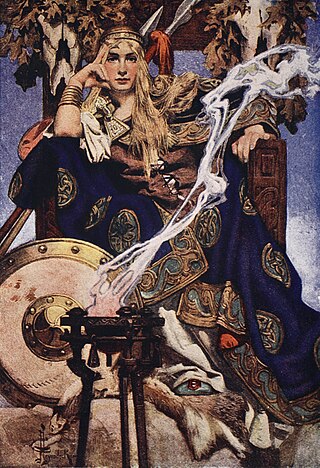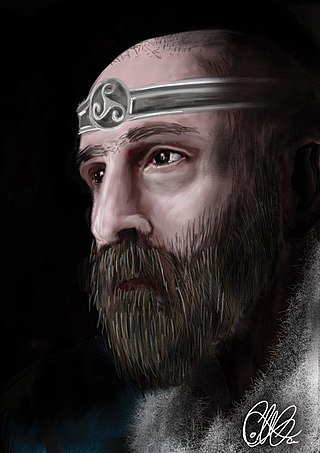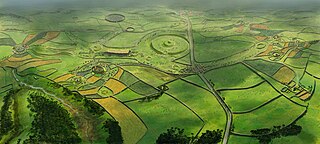Related Research Articles

The Morrígan or Mórrígan, also known as Morrígu, is a figure from Irish mythology. The name is Mór-ríoghan in modern Irish before the spelling reform, and it has been translated as "great queen" or "phantom queen".

Samhain or Sauin is a Gaelic festival on 1 November marking the end of the harvest season and beginning of winter or the "darker half" of the year. It is also the Irish and Scottish Gaelic name for November. Celebrations begin on the evening of 31 October, since the Celtic day began and ended at sunset. This is about halfway between the autumnal equinox and winter solstice. It is one of the four Gaelic seasonal festivals along with Imbolc, Bealtaine, and Lughnasa. Historically it was widely observed throughout Ireland, Scotland, and the Isle of Man. Its Brittonic Celtic equivalent is called Calan Gaeaf in Wales.
Cormac mac Airt, also known as Cormac ua Cuinn or Cormac Ulfada, was, according to medieval Irish legend and historical tradition, a High King of Ireland. He is probably the most famous of the ancient High Kings, and may have been an authentic historical figure, although many legends have attached themselves to him, and his reign is variously dated as early as the 2nd century and as late as the 4th. He is said to have ruled from Tara, the seat of the High Kings of Ireland, for forty years, and under his rule, Tara flourished. He is credited for building many of the monuments at the Hill of Tara such as the Banqueting Hall, Cormac's house, and Gráinne's Enclosure, named after his daughter. He was famous for his wise, true, and generous judgments. In the Annals of Clonmacnoise, translated in 1627, he is described as:
"absolutely the best king that ever reigned in Ireland before himself...wise learned, valiant and mild, not given causelessly to be bloody as many of his ancestors were, he reigned majestically and magnificently".

In Gaelic myth, the Cailleach is a divine hag and ancestor, associated with the creation of the landscape and with the weather, especially storms and winter. The word literally means 'old woman, hag', and is found with this meaning in modern Irish and Scottish Gaelic, and has been applied to numerous mythological and folkloric figures in Ireland, Scotland, and the Isle of Man. In modern Irish folklore studies, she is sometimes known as The Hag of Beara, while in Scotland she is known as Beira, Queen of Winter.

Fergus mac Róich/Róigh is an Irish hero and a character in the Ulster Cycle of Irish mythology. Formerly the king of Ulster, he is tricked out of the kingship and betrayed by Conchobar mac Nessa, becomes the ally and lover of Conchobar's enemy, queen Medb of Connacht, and joins her expedition against Ulster in the Táin Bó Cúailnge. Fergus is described as being of huge size and sexual potency. This leads him into many a precarious situation as in the story of the Táin Bó Flidhais.

Medb, later spelled Meadhbh, Méabh(a) and Méibh, and often anglicised as Maeve, is queen of Connacht in the Ulster Cycle of Irish mythology. Her husband in the core stories of the cycle is Ailill mac Máta, although she had several husbands before him who were also kings of Connacht. She rules from Cruachan. She is the enemy of Conchobar mac Nessa, king of Ulster, and is best known for starting the Táin Bó Cúailnge to steal Ulster's prize stud bull Donn Cúailnge.

Ailill mac Máta is the king of the Connachta and the husband of queen Medb in the Ulster Cycle of Irish mythology. He rules from Cruachan.

Rathcroghan is a complex of archaeological sites near Tulsk in County Roscommon, Ireland. It is identified as the site of Cruachan, the traditional capital of the Connachta, the prehistoric and early historic rulers of the western territory. The Rathcroghan Complex is a unique archaeological landscape with many references found in early Irish medieval manuscripts.

Táin Bó Cúailnge, commonly known as The Táin or less commonly as The Cattle Raid of Cooley, is an epic from Irish mythology. It is often called "the Irish Iliad", although like most other early Irish literature, the Táin is written in prosimetrum, i.e. prose with periodic additions of verse composed by the characters. The Táin tells of a war against Ulster by Queen Medb of Connacht and her husband King Ailill, who intend to steal the stud bull Donn Cuailnge. Due to a curse upon the king and warriors of Ulster, the invaders are opposed only by the young demigod, Cú Chulainn.

The Ulster Cycle, formerly known as the Red Branch Cycle, is a body of medieval Irish heroic legends and sagas of the Ulaid. It is set far in the past, in what is now eastern Ulster and northern Leinster, particularly counties Armagh, Down and Louth. It focuses on the mythical Ulster king Conchobar mac Nessa and his court at Emain Macha, the hero Cú Chulainn, and their conflict with the Connachta and queen Medb. The longest and most important tale is the epic Táin Bó Cúailnge. The Ulster Cycle is one of the four 'cycles' of Irish mythology and legend, along with the Mythological Cycle, the Fianna Cycle and the Kings' Cycle.
Bricriu is a hospitaller (briugu), troublemaker and poet in the Ulster Cycle of Irish mythology.

In the Ulster Cycle of Irish mythology Donn Cúailnge, the Brown Bull of Cooley, was an extremely fertile stud bull over whom the Táin Bó Cúailnge was fought.
Fráech is a Connacht hero and demigod in the Ulster Cycle of Irish mythology. He is the nephew of Boann, goddess of the river Boyne, and son of Idath of the men of Connaught and Bébinn, and is renowned for his handsomeness and exploits. He belongs to the Fir Domnann.

In Celtic mythology, the Otherworld is the realm of the deities and possibly also the dead. In Gaelic and Brittonic myth it is usually a supernatural realm of everlasting youth, beauty, health, abundance and joy. It is described either as a parallel world that exists alongside our own, or as a heavenly land beyond the sea or under the earth. The Otherworld is usually elusive, but various mythical heroes visit it either through chance or after being invited by one of its residents. They often reach it by entering ancient burial mounds or caves, or by going under water or across the western sea. Sometimes, they suddenly find themselves in the Otherworld with the appearance of a magic mist, supernatural beings or unusual animals. An otherworldly woman may invite the hero into the Otherworld by offering an apple or a silver apple branch, or a ball of thread to follow as it unwinds.
Caíltemac Rónáin was a nephew of Fionn mac Cumhaill, a warrior and a member of the fianna in the Fenian Cycle of Irish mythology. He is described as being able to run at remarkable speed and communicate with animals, and was a great storyteller. Some poems of the Fenian Cycle are attributed to Caílte.

Scottish mythology is the collection of myths that have emerged throughout the history of Scotland, sometimes being elaborated upon by successive generations, and at other times being rejected and replaced by other explanatory narratives.

Tulsk is a village in County Roscommon, Ireland, on the N5 national primary road between Strokestown and Bellanagare. It sits at around 19 km north of Roscommon town.
Amergin mac Eccit is a poet and warrior in the court of Conchobar mac Nessa in the Ulster Cycle of Irish mythology. He was the son of Eccet Salach, a smith, and grew to the age of fourteen without speaking or washing himself. One day Athirne, the Ulaid's chief poet, sent his servant to Eccet to order an axe. The servant was shocked when Amergin uttered a precocious, cryptic poem, and ran home to tell his master what he had heard.

Táin Bó Flidhais, also known as the Mayo Táin, is a tale from the Ulster Cycle of early Irish literature. It is one of a group of works known as Táin Bó, or "cattle raid" stories, the best known of which is Táin Bó Cúailnge. Táin Bó Flidhais survives in two forms, a short version from the Old Irish period and a longer version found in the 15th century Glenmasan manuscript, which is held in the Advocates Library in Edinburgh. It is believed to be a copy of an earlier manuscript from the 12th century. The early version of Táin Bó Flidhais predates the Táin Bó Cúailnge. It is named for the heroine of the tale, Flidais.
Carnfree is a site south of the village of Tulsk in Roscommon that also lies close to the more celebrated ancient landscape of Rathcroghan. The chief feature here is the bronze-age mound of Carnfree itself, believed to be the cairn of the Connacht warrior Fráech, that was used as an inauguration place up to late medieval times. It also encompasses an area known as Selc featuring Duma Selga and the ecclesiastical site where Saint Patrick baptised the Ui Brian princes of Connacht, who according to the saint's biography may have resided in or administrated from this area.
References
- ↑ Watson, Alden (1986). "A structural analysis of Echtra Nerai". Études celtiques. 23 (1): 129–142. doi:10.3406/ecelt.1986.1819.